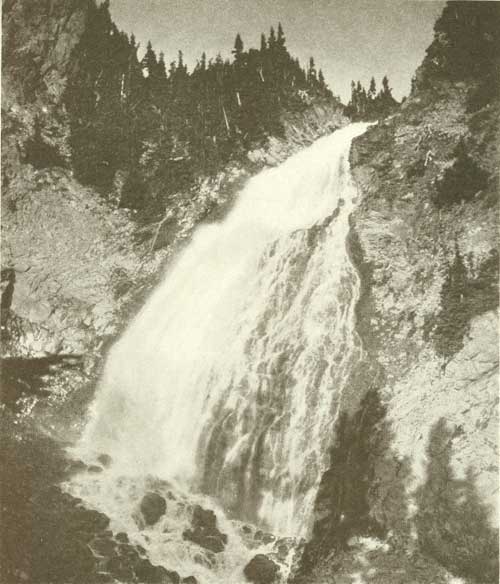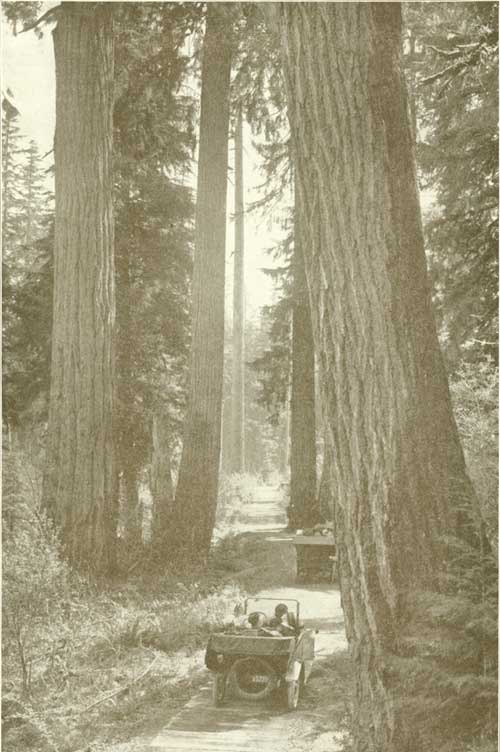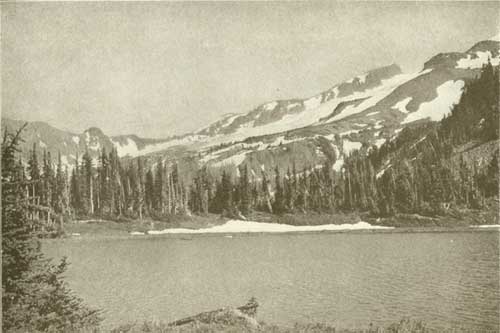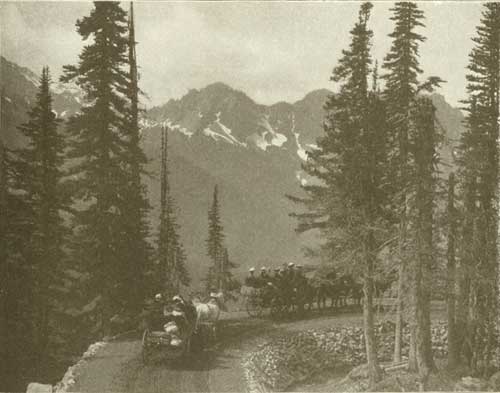|
NATIONAL PARKS PORTFOLIO
|
MOUNT RAINIER NATIONAL PARK
GLACIER AND WILD FLOWER
 ROBABLY no glacier of large size in the world is so
quickly, easily, and comfortably reached as the most striking and
celebrated, though by no means the largest, of Mount Rainier's, the
Nisqually Glacier. It descends directly south from the snowy summit in a
long curve, its lower finger reaching into park-like glades of luxuriant
wild flowers. From Paradise Valley one may step directly upon its
fissured surface.
ROBABLY no glacier of large size in the world is so
quickly, easily, and comfortably reached as the most striking and
celebrated, though by no means the largest, of Mount Rainier's, the
Nisqually Glacier. It descends directly south from the snowy summit in a
long curve, its lower finger reaching into park-like glades of luxuriant
wild flowers. From Paradise Valley one may step directly upon its
fissured surface.
The Nisqually Glacier is five miles long and, at Paradise Valley, is half a mile wide. Glistening white and fairly smooth at its shining source on the mountain's summit, its surface here is soiled with dust and broken stone and squeezed and rent by terrible pressure into fantastic shapes. Innumerable crevasses, or cracks many feet deep, break across it caused by the more rapid movement of the glacier's middle than its edges; for glaciers, like rivers of water, develop swifter currents nearer midstream.
Professor Le Conte tells us that the movement of Nisqually Glacier in summer averages, at midstream, about sixteen inches a day. It is far less at the margins, its speed being retarded by the friction of the sides.
Like all glaciers, the Nisqually gathers on its surface masses of rock with which it strews its sides just as rivers of water strew their banks with logs and floating debris. These are called lateral moraines, or side moraines. Sometimes glaciers build lateral moraines miles long and over a thousand feet high. The Nisqually ice is more than a thousand feet thick in places.
The rocks which are carried in midstream to the end of the glacier and dropped when the ice melts are called the terminal moraine. As the glacier recedes the terminal moraine stretches into an ever lengthening medial moraine.
The end, or snout, of the glacier thus always lies among a great mass of rocks and stones. The Nisqually River flows from a cave in the end of the Nisqually Glacier's snout, for the melting begins several miles up-stream under the glacier. The river is milky white when it first appears because it carries sediment and powdered rock which, however, it soon deposits, becoming clear.
But this brief picture of the Mount Rainier National Park would miss its loveliest touch without some notice of the wild-flower parks lying at the base, and often reaching far up between the icy fingers, of Mount Rainier.
"Above the forests," writes John Muir, the celebrated naturalist, "there is a zone of the loveliest flowers, fifty miles in circuit and nearly two miles wide, so closely planted and luxurious that it seems as if nature, glad to make an open space between woods so dense and ice so deep, were economizing the precious ground and trying to see how many of her darlings she can get together in one mountain wreath—daisies, anemones, columbine, erythroniums, larkspurs, etc., among which we wade knee-deep and waist-deep, the bright corollas in myriads touching petal to petal. Altogether this is the richest subalpine garden I have ever found, a perfect flower elysium."

|
|
MOUNT BAKER FROM MOUNT RAINIER—A HUNDRED AND FORTY MILES NORTHWARD Photograph by Curtis & Miller. |

|
|
THE NORTH SLOPES OF MOUNT RAINIER ARE WELL ADAPTED TO BECOME THE HEALTH
AND PLEASURE GARDENS OF MANY THOUSANDS The superb north side has been seen by very few visitors owing to its inaccessibility, but the Department of the Interior is planning its development Copyright, 1903, by W. P. Romans, Seattle |

|
|
BEAUTIFUL PARADISE VALLEY SHOWING THE TATOOSH RIDGE Photograph by Curtis & Miller |

|
|
TIMBER-LINE AND FLOWER FIELDS IN BEAUTIFUL PARADISE VALLEY Photograph by Curtis & Miller |

|
|
THE MORNINGS OFTEN ROLL TOSSING SEAS OF MIST INTO THE VALLEYS, FROM
WHICH EMERGE AT INTERVALS CRAGGY TOPS, GLISTENING GLACIERS, AND
FAR-DISTANT MOUNTAIN PEAKS This photograph was taken from a height at Indian Henry's. Mount St. Helens is lost in the mists forty miles away. Photograph by Curtis & Miller |

|
|
COMET FALLS Photograph by Curtis & Miller |

|
|
SLUISKAN FALLS Photograph by Curtis & Miller |

|
|
THE ROADS LEAD TO THE GLACIERS THROUGH FORESTS OF FIR AND CEDAR Photograph by Curtis & Miller |

|
| CRATER LAKE (UNFORTUNATELY NAMED) A NORTH-SIDE GEM OF BEAUTY |

|
|
THE ROADS ARE ADMIRABLE Photograph by Curtis & Miller |
| <<< Previous | <<< Contents>>> | Next >>> |
yard1/mora4.htm
Last Updated: 30-Oct-2009